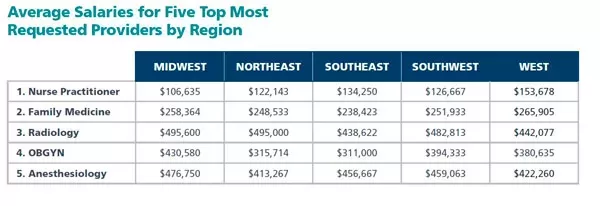Family practice physicians average $255,000 in salary, while NPs and PAs average $151,000; the vast majority of healthcare employers compensate providers for continuing education and offer educational loan forgiveness
by Intelliworx
As far as benchmarking goes in healthcare recruiting, the AMN Healthcare (formerly Merritt Hawkins) annual report on recruiting incentives is very credible. The organization has been producing the report based on talent searches it has conducted for the last 30 years.
This year, the report is based on 2,676 permanent positions the organization has filled for physicians and advanced providers, such as nurse practitioners (NPs) and physician assistants (PAs).
We’ve previously covered some of the takeaways we gleaned from the report on market dynamics and the competition for talent. This post will summarize some of the key benchmarks for financial incentives in healthcare.
1. Provider salary ranges and averages
AMN says it conducted more searches for NPs than any other title for the third year in a row, largely due to demand from retail and urgent care clinics. For this reporting period, they conducted 420 searches for NP candidates, followed by 279 for family medicine physicians.
- Family medicine physician salaries range from $120,000 to $375,000, with an average of $255,000; and
- NP and PA salaries range from $115,000 to $271,000, with an average of $151,000.
The report also covers salary ranges for many specialists. Here are two from the high and low end of the bands:
- Radiologist salaries range from $370,000 to $693,000, with an average of $472,000; and
- Pediatric salaries range from $190,000 to $276,000, with an average of $233,000 on the low end.
Another survey has shown that compensation is the single biggest factor that would motivate a newly credentialed provider to accept a role with a rural hospital.
(click image for high resolution)
2. Relocation expenses paid
More than half (62%) of all searches included financial incentives for the successful candidates to relocate.
- Physician relocation expenses range from $3,000 to $150,000, with an average of $12,778; and
- NP and PA relocation expenses range from $2,000 to $25,000, with an average of $7,997.
3. Provider signing bonuses
Most healthcare organizations (63%) also included signing bonuses for candidates who were offered a position and accepted.
- Physicians signing bonuses range dramatically from $500 to $570,000, with an average of $37,473; and
- NP and PA signing bonuses range from $2,000 to $25,000, with an average of $8,355.
4. Pay for continuing medical education (CME)
A whopping 93% of healthcare employers compensate providers for continuing medical education.
- Physicians range from $3,000 to $45,000, with an average of $3,840; and
- NP and PA range from $1,000 to $5,000, with an average of $2,299.
5. Educational loan forgiveness
Educational loan forgiveness had even higher participation from healthcare employers. The participation rate was 100% for this sample, which suggests how important this benchmark is for recruiting providers.
- 5% of employers offer education loan forgiveness after one year in a role;
- 11% of employers offer education loan forgiveness after two years in a role; and
- 84% of employers offer education loan forgiveness after three years in a role;
And the ranges?
- Physician education loan forgiveness packages range from $10,000 to $400,000, with an average of $98,665; and
- NP and PA education loan forgiveness packages range from $10,000 to $140,000, with an average of $70,769.
The full report contains many more benchmarks and is well worth the time to peruse. You can download it here: 2023 Review of Physician and Advanced Practitioner Recruiting Incentives.
* * *
Our new Workforce Management software solution is designed to facilitate provider recruiting for rural healthcare facilities. Contact us for a no-obligation demo.
If you enjoyed this post, you might also like:
Recruiting: 5 emerging sources of healthcare are adding new competition for talent




